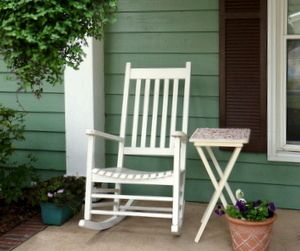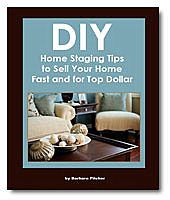Do you dislike the thought of putting money into a home that you’ll be leaving?
I’ve learned that effective home staging doesn’t have to be expensive. Your home can attract good offers even if you don’t have a big staging budget.
Or a mother-in-law who will loan you her antiques.
Or an interior designer friend who will take your hand.
Or a husband who loves fix-it projects and has the time to tackle them.
You can do your own staging and you can do it inexpensively. There are only two tricks to it.
Prioritize: Decide What’s Important
Maybe you’ve already made that list of what needs tweaking, cleaning, organizing, or dressing up. My first trick is to separate the Must-Do from the It-Would-Be-Nice-To-Do. Ask yourself:
- Left undone, would this task or purchase give me black marks on an official home inspection?
- Is this something I have wanted to do almost from the time I moved into my home?
- Can this be accomplished without a reconfiguring of plumbing or electrical systems?
- Is this something family members, visitors, and others also think is a good idea?
- Is it a change I can take with me when I move?
- Does it offer good return on my investment?
- Do these changes represent features many buyers want, such as an eat-in kitchen, updated basement, or a modern outdoor living space ?
- Do other homes in my market, at my price point, offer this kind of feature?
- Does the improvement expand usable square footage?
- Does the improvement make the home easier to maintain or conserve energy?
 |
| A home office is something most buyers want. If you can tuck one into a narrow space, you'll be ahead of the game. If you can do it on budget, you'll get good return on investment. Photo:LampsPlus |
These are the projects that should take your time and money. Either eliminate or place low on your to-do list those items to which you answered “no.”
But how much money should you spend? Real estate experts suggest spending one to two percent on improvements when you’re planning to sell your home.
It’s always reassuring to know that statistically you’re within guidelines. That means if you plan to list your home for $250,000, your staging budget should be between $2,500 and 5,000.
It’s always reassuring to know that statistically you’re within guidelines. That means if you plan to list your home for $250,000, your staging budget should be between $2,500 and 5,000.
You’ll want to spend it wisely. That’s where the second trick comes into play.
Source Right: Make Economical Purchases
Get Discounts. Always inquire about price reductions. Don’t demand, just ask.
Ask people who do work for you if they give discounts for paying with cash, or if you pay an invoice within the first week of receiving it.
Ask stores if they give discounts to military, ministerial, disability, AAA, students, or seniors if you qualify for those groups.
Ask if the item is going to go on sale. Watch for sales. Print or clip and use coupons. Even if you don’t have a coupon for a store, ask the salesperson if you qualify for one.
Stores will often discount the last item in a line of bedding, or the end of a bolt of fabric, or a chair that's been a floor sample, or a dishwasher missing a manual, or a lamp with a chip you'll never notice. But only if you ask!
Shop where you have a discount or loyalty card, whether online or at brick and mortar stores. Shop discount stores and outlet stores.
Buy Direct. Patronize the local stoneyard for granite. Hire a handyman from your own hometown or neighborhood. Visit the largest area discount nursery for landscape shrubbery. Use online companies like Dalton for carpets.
Sometimes buying direct means buying local, and sometimes it means shopping nationwide for the best deal.
Buy Second Hand. Don’t turn up your nose at these kinds of outlets. Often you can find second hand places that sell appliances and furniture that look brand new. This could be scratch and dent merchandise, very slightly used, or come from a model home or manufacturer’s closeout.
Furniture from places like Salvation Army and ReStore have frequently been donated by people with money and taste. Garage sales are a source of deeply discounted furniture, appliances and accessories for staging because sellers are usually motivated. Your purchases may need minor repairs or just a coat of paint to make them perfect for staging your home.
Furniture from places like Salvation Army and ReStore have frequently been donated by people with money and taste. Garage sales are a source of deeply discounted furniture, appliances and accessories for staging because sellers are usually motivated. Your purchases may need minor repairs or just a coat of paint to make them perfect for staging your home.
Know when to say yes to DIY. If you clean your own home as though you were detailing your car, if you paint your walls like a pro, if you mulch and prune your own landscaping, if you declutter and organize your own closets, you’ve put money in your pocket.
When I first began studying real estate, one of my teachers used to tell the class, “If you will do what others are not willing to do, you will have what others do not have.” It was just a new way of saying, “Work hard.” Or as Mike Rowe, one of my heroes, likes to say, “Work smart AND hard.”
But there are also times when not hiring a professional or a qualified tradesperson is shortsighted (or illegal according to building codes and local ordinances). If you decide to lay ceramic tile in your bathroom and you’ve never laid tile before, the results could actually detract from the value of your home.
Plan Ahead. Most trades and products have a downtime, a period when their cost is lower than usual. Although it may be difficult to plan much in advance when you are staging your home, and you don’t know how long you’ll be living in your home, this scheduling approach is still worth considering.
For example, buy heating fuel in the summer. Buy patio furniture and grills in October. And hire the heating and cooling guy in the spring or fall.
The Lessons
Remember that if you spend $5,000, you can’t expect to raise your asking price $5,000. But you might sell your home faster, so fast that you’ll save more than $5,000 in carrying costs like insurance, mortgage interest, taxes and utilities.
Keep the big picture in mind, and don’t expect to make a huge profit by selling your home.
Selling a home is like running a small business, so think like an entrepreneur and make all your staging decisions cost effective ones. Time and money both have to be budgeted if you’re going to stay sane and get the job done. These are the simple techniques I’ve used and I’ve seen others use to make home staging cost effective, and you can do it, too.
There's more of this kind of sanity-saving advice in my home staging eBooks. You can download them instantly and begin staging your own home today. They’re only $5 each!
Top Photo: BHG







No comments:
Post a Comment